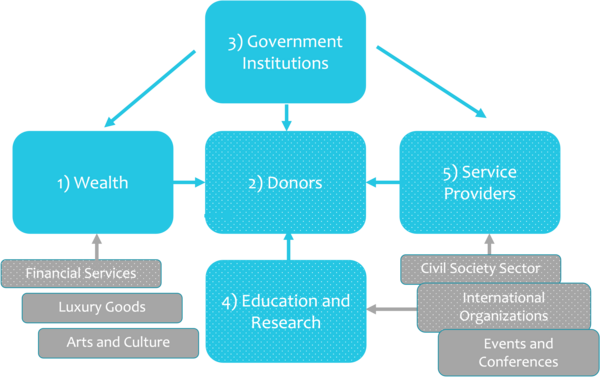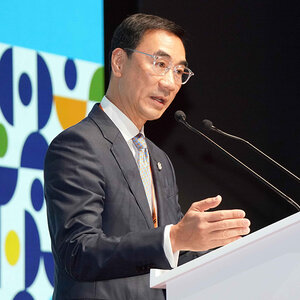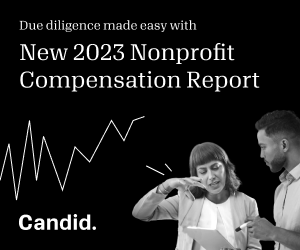The power of clusters: Building a strong philanthropy ecosystem in Asia

Recognizing that philanthropy and other types of private social investment are increasingly important facets of a family’s vision of the resources they seek to both grow and deploy, Hong Kong and Singapore are endeavoring to become family offices. In Singapore, the Temasek Trust’s Philanthropy Asia Alliance is holding an annual summit to establish philanthropy as a key component of its family office offerings. In Hong Kong, the government is planning a follow-up to its Wealth for Good Summit, held earlier this year, where philanthropy was one of four central pillars set out by the government to court wealthy families to the city.
While there is more money in the region, the lack of collaboration and cooperation among various stakeholders has hindered the development of effective and sustainable solutions.
How are collaborative ecosystems which enable different and at times competing entities to effectively work together allow for greater impact, energy, and dynamism? One promising approach is the “cluster framework,” originally developed by Michael E. Porter to explain the success of different clusters, including tech in Silicon Valley and wine in Napa Valley. Utilizing this model for a philanthropic cluster would encompass five key elements: wealth, donors, government institutions, education and research, and service providers (philanthropy-serving institutions) or associations.
Creating synergy: The philanthropy cluster model
Figure 1. The philanthropy cluster model developed by CAPS
Wealth
Asia has some of the world's wealthiest individuals and families, creating a favorable economic environment for philanthropy clusters to emerge. China's wealth has increased significantly in the last decade, resulting in a rise in philanthropic giving. In 2018, philanthropic donations of ¥1 million ($154,560) or more amounted to ¥27.63 billion ($4.27 billion), up 50 percent from the previous year and almost four times that of a decade ago.
Donors
Donors are the lifeblood of philanthropic organizations. By providing financial resources, expertise, and networks, donors can support the growth and effectiveness of the social sector and foster a culture of giving. Moreover, they can advocate for philanthropy, encouraging others to give and raising awareness about important social issues.
In the words of philanthropist Cao Dewang, “[i]n Chinese culture, we are imbued with the reciprocity mindset. You have to bear social responsibility while you make money. When the gap between the rich and the poor further widens in our nation, we as entrepreneurs should stand up and take this responsibility.”
Government institutions
In order to foster a robust and sustainable philanthropic sector throughout Asia, government institutions can put in place through policies and regulations that encourage philanthropic activities and partnerships with the private sector.
For example, Singapore boasts the most attractive philanthropic tax incentives in the world, with a 250 percent tax deduction rate for charitable donations and no limit on eligible income. This has contributed to a rise in the number of family offices established there recently. Additionally, the Wealth Management Institute (WMI) partnered with the private banking industry to provide training for private bankers to better serve clients'’ philanthropic needs.
Education and research institutions
Research and education are also critical to advancing the philanthropy sector, as they help to build a stronger evidence base and inform policy and practice. Research organizations such as the Center for Effective Philanthropy, the Stanford Center on Philanthropy and Civil Society (PACS), and Candid in the United States and the Centre for Asian Philanthropy and Society (CAPS) based in Hong Kong develop thought leadership through evidence-based research, advisory services, and philanthropy conferences.
In Asia, several reputable universities also have emerged as leaders in developing the philanthropy sector. For example, the Hong Kong University of Science and Technology offers a master's degree in Global Leadership and Social Entrepreneurship, while the Lee Kuan Yew School of Public Policy at the National University of Singapore has a master's degree program in Philanthropy and Non-Profit Leadership.
Service providers (philanthropy-serving institutions)/associations
Philanthropy-serving institutions and associations play a critical role in supporting private social investment by providing specialized expertise, knowledge, and services. Throughout Asia, banks with private wealth services as well as family office advisory services are increasingly offering information and support for a portfolio approach to investments which include philanthropy and impact investing.
Moreover, philanthropy-serving institutions and associations can help foster networking and collaboration among philanthropic organizations and donors. For example, Singapore’s philanthropy ecosystem has been significantly strengthened by the networking and convening of several philanthropy organizations, including the Asia Venture Philanthropy Network and Asia Philanthropy Circle, which help build strong regional networks of philanthropists and corporate donors. In Hong Kong, CAPS convenes philanthropists from across the region on a regular basis, as does the Hong Kong Jockey Club Trust.
Connecting the dots: The key to a philanthropy cluster
However, getting different groups to work together toward a shared goal can be challenging. Additionally, building trust and transparency between stakeholders is essential. Each stakeholder group must contribute to the establishment of a philanthropy cluster in Asia.
Companies can allocate funds toward initiatives that align with their values and expertise. Collaborating with local nonprofits and NGOs, encouraging employees to volunteer their time, and partnering with other companies can help maximize impact and create a sustainable philanthropy ecosystem.
High-net-worth individuals can establish foundations or funds, engage with local nonprofits and NGOs, attend philanthropy-focused networking events and conferences, and partner with companies and other philanthropic organizations to maximize impact and support sustainable solutions.
Governments can foster an ecosystem of support for innovation, collaboration, and long-term impact by creating policies and incentives that encourage philanthropic initiatives—including infrastructure, financial support, and tax incentives, , as well as legal frameworks which prioritize transparency, accountability, and good governance.
Research and education institutions can promote innovation and collaboration by offering training and support to nonprofit leaders supporting knowledge sharing, and engaging with government and private sectors.
Philanthropy-serving institutions can support nonprofits and research organizations by providing resources and pro bono services to increase efficiency, engaging with companies and high-net-worth individuals to identify opportunities for partnership and collaboration, and promoting philanthropy awareness through events and conferences.
Building a philanthropy cluster requires a deep understanding of the challenges involved and a willingness to work collaboratively toward a shared goal. It is a long-term process that requires sustained effort and investment from multiple stakeholders.
Unlocking the potential: Building a collaborative ecosystem for long-term impact
There is enormous potential for philanthropy in Asia, and establishing a strong cluster of philanthropists can unlock this potential. By bringing together diverse stakeholders through a philanthropy cluster, we can foster an ecosystem of support for innovation, collaboration, and long-term impact.
Developing philanthropic clusters may be challenging, but the benefits are clear: a thriving philanthropy sector that contributes to the growth and development of communities and nations. Stakeholders must collaborate to increase awareness and understanding of philanthropy, establish trust, and provide funding opportunities for small and emerging philanthropic organizations to harness philanthropy’s power to drive positive change and make a lasting impact on our societies.
Angel Chiang is director of research and advisory, Greater China, at the Centre for Asian Philanthropy and Society.









Seven principles to realize the potential of diaspora philanthropy for India